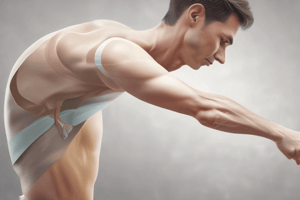Podcast
Questions and Answers
What is the primary goal of the pedaling (cycling) movement exercise described in the text?
What is the primary goal of the pedaling (cycling) movement exercise described in the text?
- To increase muscle tone in the quadriceps
- To strengthen the muscles of the affected lower extremity
- To decrease muscle tone in the quadriceps and contract the flexors (correct)
- To improve balance and trunk rotation during walking
What is the primary goal of the abduction-adduction training in side lying described in the text?
What is the primary goal of the abduction-adduction training in side lying described in the text?
- To strengthen the gluteus medius muscle
- To increase proprioception in the affected leg
- To improve hip range of motion
- To practice active control of leg movement (correct)
Why does the physiotherapist guide the patient's foot with their hand during the pedaling (cycling) movement exercise?
Why does the physiotherapist guide the patient's foot with their hand during the pedaling (cycling) movement exercise?
- To ensure the patient maintains contact with the ground during the backward sliding motion (correct)
- To help the patient achieve the full range of motion in the pedaling movement
- To prevent the patient from losing their balance
- To provide additional support and guidance for the affected lower extremity
In the dorsiflexion training by increasing sitting height, what is the purpose of having the patient lean against the wall?
In the dorsiflexion training by increasing sitting height, what is the purpose of having the patient lean against the wall?
What is the rationale behind starting the knee flexion and extension training in the semi-prone position?
What is the rationale behind starting the knee flexion and extension training in the semi-prone position?
What is the primary goal of the rhythmic arm swing training with trunk rotation exercise?
What is the primary goal of the rhythmic arm swing training with trunk rotation exercise?
Which of the following is a key benefit of the rhythmic arm swing training with trunk rotation exercise for hemiplegic patients?
Which of the following is a key benefit of the rhythmic arm swing training with trunk rotation exercise for hemiplegic patients?
What is the purpose of decreasing the trunk flexion during the knee flexion and extension training in the semi-prone position?
What is the purpose of decreasing the trunk flexion during the knee flexion and extension training in the semi-prone position?
What is the primary reason that hemiplegic patients often walk without trunk rotation?
What is the primary reason that hemiplegic patients often walk without trunk rotation?
Which of the following is a key principle of the Brunnstrom approach as described in the text?
Which of the following is a key principle of the Brunnstrom approach as described in the text?
What is the primary benefit of the rhythmic arm swing training with trunk rotation exercise for hemiplegic patients, even if normal arm swing cannot be achieved?
What is the primary benefit of the rhythmic arm swing training with trunk rotation exercise for hemiplegic patients, even if normal arm swing cannot be achieved?
Which of the following is a common challenge that the Brunnstrom approach aims to address in the rehabilitation of patients with neurological conditions?
Which of the following is a common challenge that the Brunnstrom approach aims to address in the rehabilitation of patients with neurological conditions?
Which of the following is NOT a goal of lower extremity training in the Brunnstrom approach?
Which of the following is NOT a goal of lower extremity training in the Brunnstrom approach?
During Phase I of the Brunnstrom approach, which of the following motions is performed to train the extensor synergy?
During Phase I of the Brunnstrom approach, which of the following motions is performed to train the extensor synergy?
Which of the following reflexes is used during lower extremity training in the Brunnstrom approach?
Which of the following reflexes is used during lower extremity training in the Brunnstrom approach?
In Phase I of the Brunnstrom approach, how is the perception of foot base pressure and hip flexor training achieved?
In Phase I of the Brunnstrom approach, how is the perception of foot base pressure and hip flexor training achieved?
Which of the following is a key focus of lower extremity training in the Brunnstrom approach?
Which of the following is a key focus of lower extremity training in the Brunnstrom approach?
What is the primary goal of Phase II in the Brunnstrom approach to lower extremity rehabilitation?
What is the primary goal of Phase II in the Brunnstrom approach to lower extremity rehabilitation?
Flashcards are hidden until you start studying




